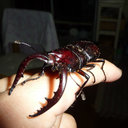Identification of a gene encoding glutathione S-transferase that is related to anthocyanin accumulation in buckwheat (Fagopyrum esculentum).
Keywords
Abstract
Anthocyanins are a group of flavonoids found in buckwheat (Fagopyrum esculentum) and many other plant species; however; little is known about their mechanisms of synthesis and regulation in buckwheat. We previously reported a spontaneous mutant buckwheat line that shows the green stem phenotype; this line does not accumulate anthocyanins but synthesizes flavonol and proanthocyanidin in the stem. Here, we used this line and lines developed by this line to search for genes related to anthocyanin accumulation in buckwheat. The lines with green stem showed flavonoid-3-O-glucosyltransferase activity against UDP-glucose, indicating that the flavonoid-3-O-glucosyltransferase gene was not controlling the green stem trait. We therefore searched the buckwheat genome database for a gene encoding glutathione S-transferase (GST), a flavonoid-binding protein that transports flavonoids to the vacuole, and identified a candidate gene, FeGST1. Expression analysis showed that FeGST1 was expressed in wild type buckwheat but not in the green stem lines. Linkage analysis with an F2 segregating population produced by crossing between the green stem line and a self-compatible line showed that FeGST1 segregated with stem color without any recombination. This indicates that the green stem trait could be caused by homozygous non-functional alleles of the FeGST1 locus.


